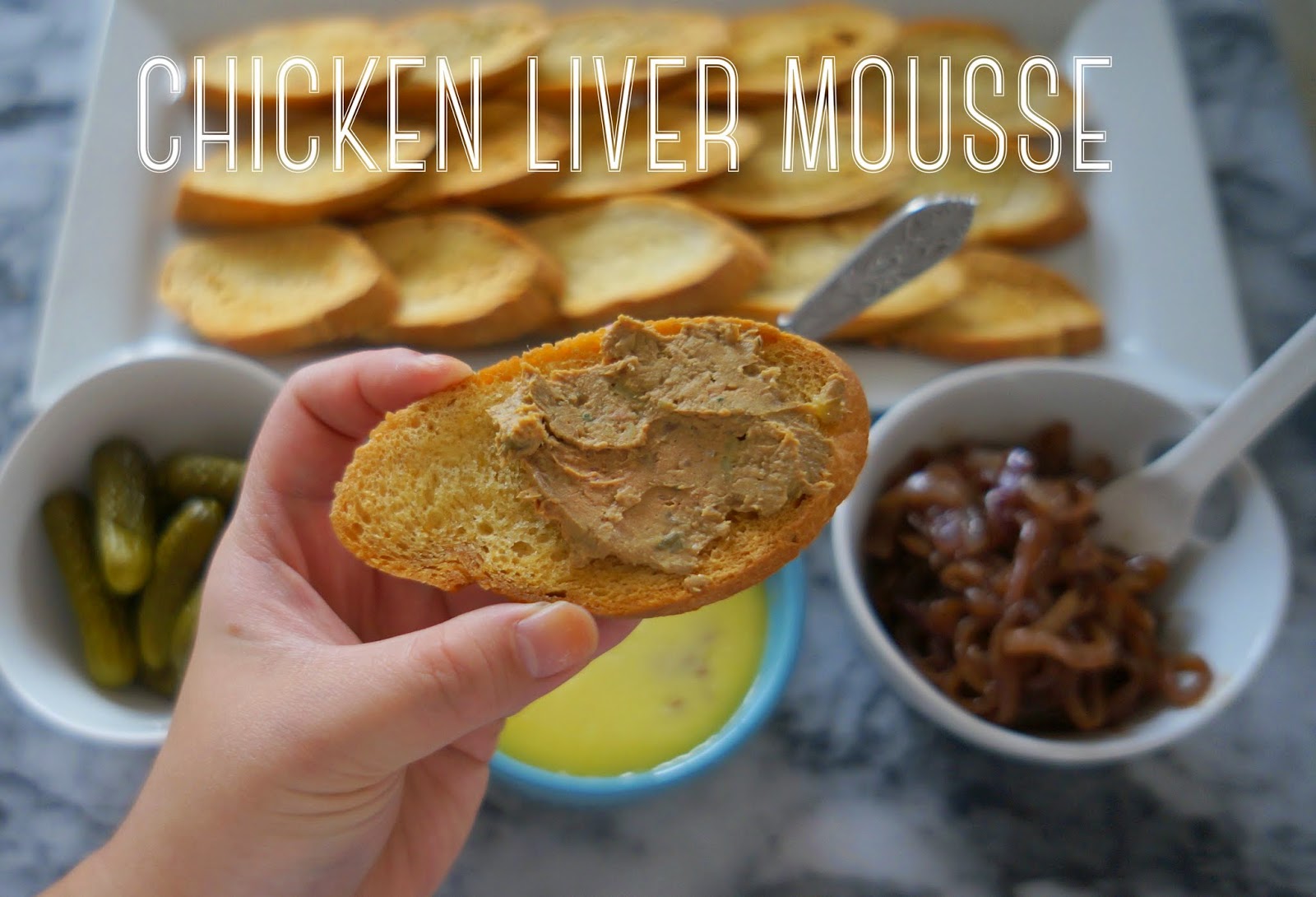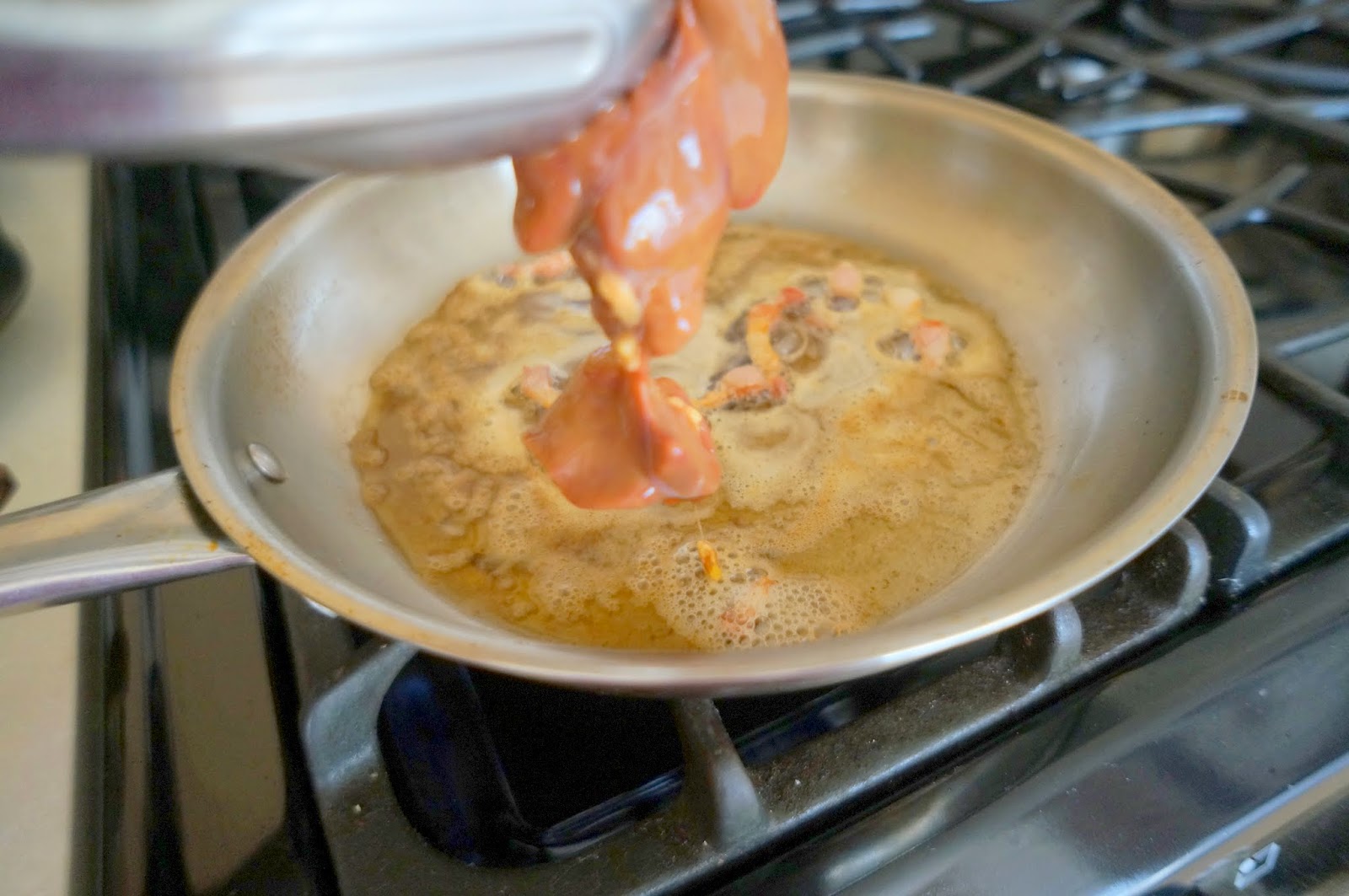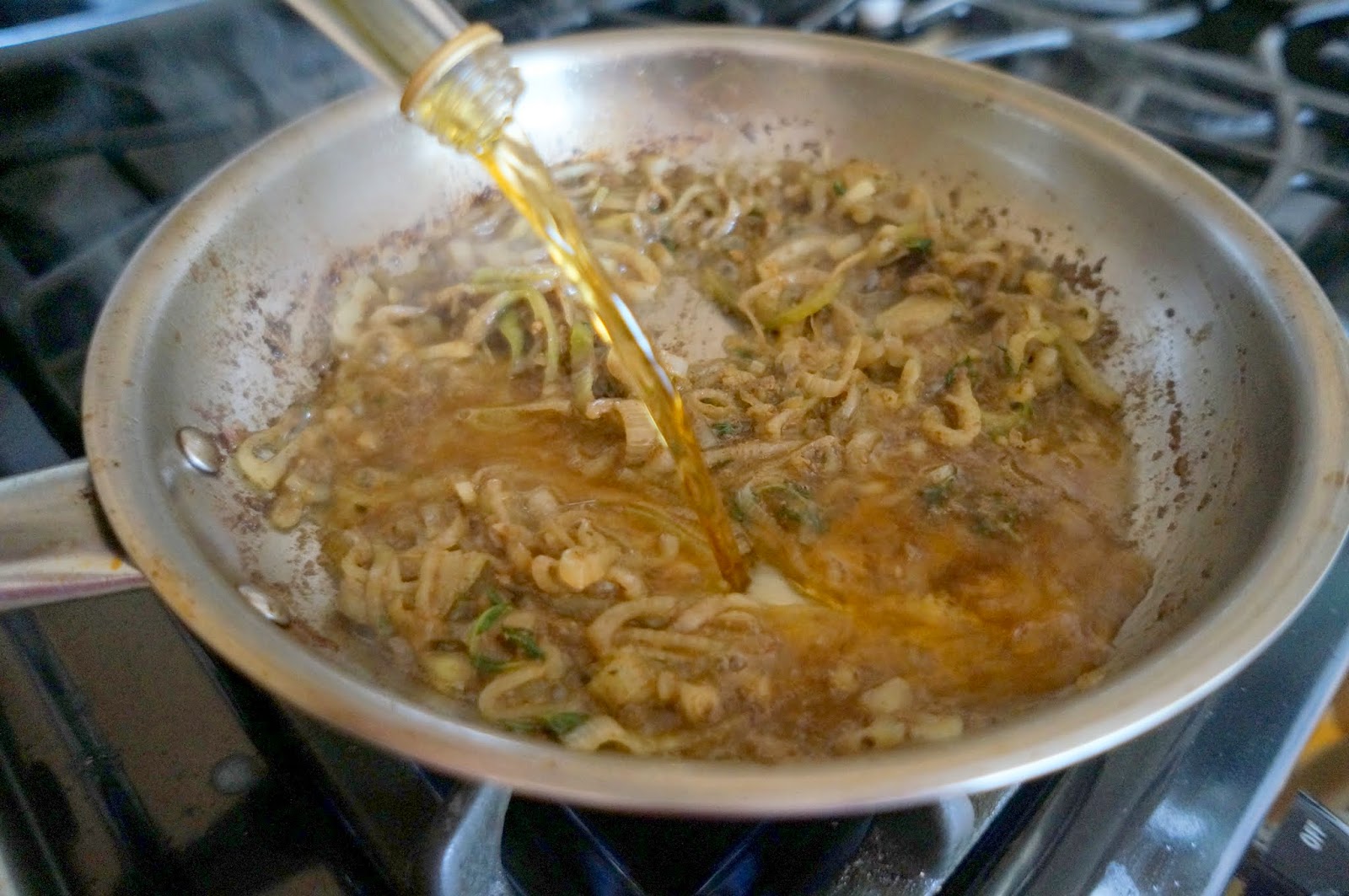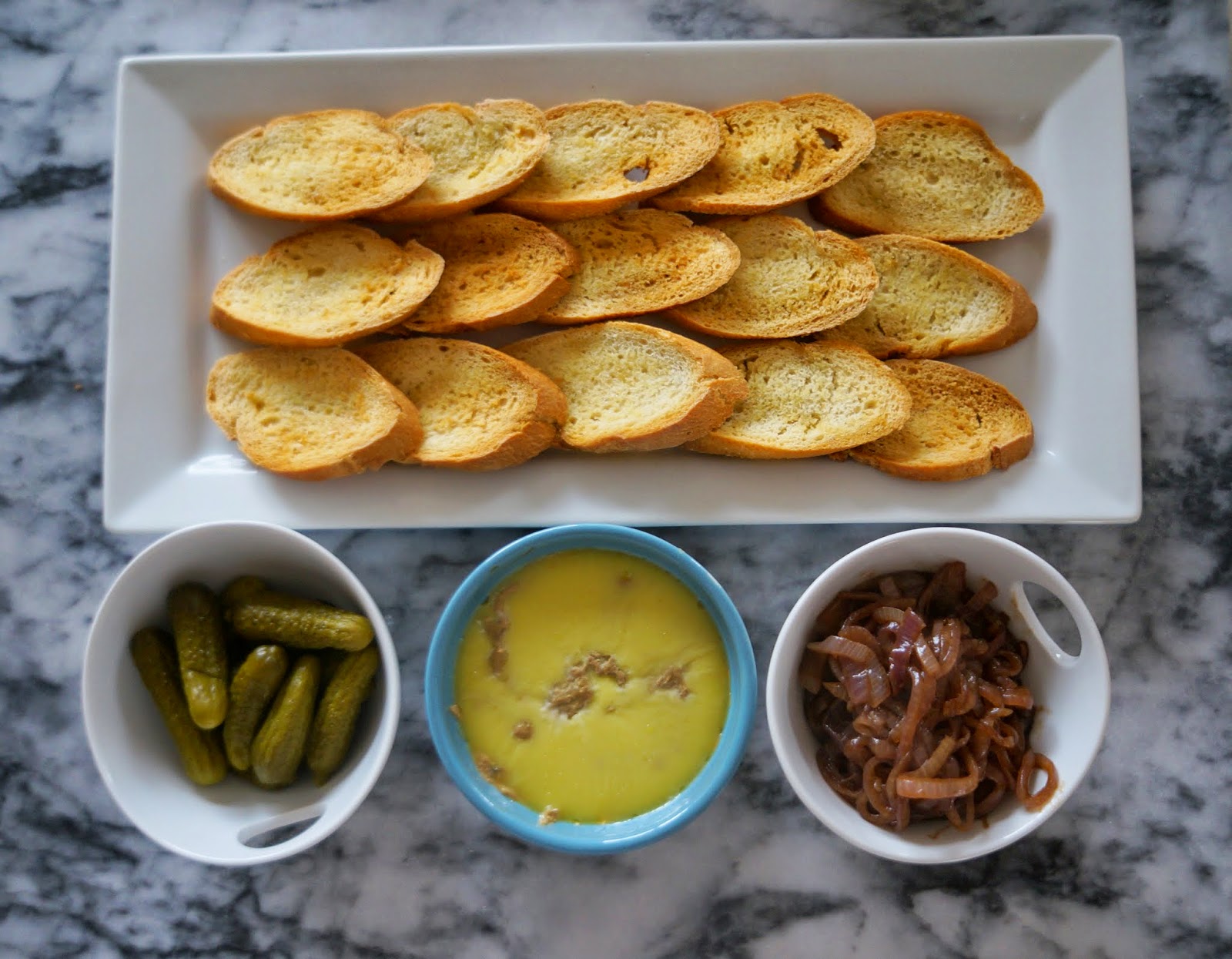Chicken Liver Mousse
A few weekends ago, baby sister and I went to Philadelphia to visit my cousin and her husband. While we were there, we visited the Mutter Museum and we ate at Tria. I mention these two specific things, as they relate to today's post. The Mutter Museum, because it's gross and you see lots of innards (mostly human) and Tria, because we ordered and ate a chicken liver mousse, which was delicious. The meal at Tria (and maybe a bit of the Mutter Museum visit) inspired me to make a chicken liver mousse at home.
Organs are not a popular cut of meat and I think they skeeve most people out, including myself. Even the word, "organ" sounds disgusting, even if you're innocently talking about the ancient piano-like instrument. And to be frank, for the most part, they're not delicious, at least not to me. For one, the texture is either mushy and chalky or chewy and tendon-y. Also, the flavor tends to be much more concentrated and gamey because organs are meant to be pumping blood or cleaning blood or filtering air or other maintenance-y stuff. And of course, the shape isn't the most appealing. However, when you take a tub full of creepy little chicken livers and whizz them up with plenty of seasoning and a little booze, you end up with a super tasty spread that looks lovely and fancy that will make everyone "ohh" and "ahh."
Organs are not a popular cut of meat and I think they skeeve most people out, including myself. Even the word, "organ" sounds disgusting, even if you're innocently talking about the ancient piano-like instrument. And to be frank, for the most part, they're not delicious, at least not to me. For one, the texture is either mushy and chalky or chewy and tendon-y. Also, the flavor tends to be much more concentrated and gamey because organs are meant to be pumping blood or cleaning blood or filtering air or other maintenance-y stuff. And of course, the shape isn't the most appealing. However, when you take a tub full of creepy little chicken livers and whizz them up with plenty of seasoning and a little booze, you end up with a super tasty spread that looks lovely and fancy that will make everyone "ohh" and "ahh."
This is the perfect party appetizer because it's easy, it can be made ahead of time, and it's cheap. I mean, chicken livers are so friggin' cheap (probably because they gross everyone out) and a little goes a long way. And honestly, you don't have to tell anyone what this is. You can just set it out and if your guests are hungry enough, they'll go for it, fall in love, and become liver lovers.
Add butter and let it melt and then let it turn nice and brown. But don't let it burn! We're looking for a lightly browned butter, which will add another level of flavor and richness to the mousse.
Add the livers to the pan and season generously with salt and pepper and nutmeg. Cook until they're browned on the outside, about 4 to 6 minutes. The livers should still be slightly pink on the inside. You certainly don't want to undercook the livers but overcooking is a no-no also. If you're unsure, check the internal temperature with a thermometer and look for a temperature between 155F and 160F. Technically, the safely cooked temperature for chicken is 165F but you have to factor in the "carry over" cooking time so giving it 5 to 10 degrees wiggle room is the most prudent step.
Grab the livers and place them in a food processor.
By the time the mixture has cooked and mildly caramelized, the "sauce" left in the pan should be reduced down to a thick paste, coating the shallot pieces and there might be some delicious brown bits stuck to the bottom of the pan. This is all v. good.
Carefully pour in some cognac to deglaze the pan, stir it into the shallots, and cook for a few minutes to cook off of the alcohol (maybe 3 to 5 minutes). If you're feeling brave and adventurous, you can always grab a stick lighter and set the vapors ablaze. Otherwise, you can take the safe route (which is the one I always prefer) and let it do its own thing. If you have little to no experience with cooking with liquor, I recommend turning the heat off and removing the pan from the stove before pouring in the alcohol. Once the alcohol is in, return the pan to the stove and then turn the flame back on.
By the way, you should always have a fire extinguisher in the house and ideally, it should be located in the kitchen. Make sure it's a class K extinguisher, as these are specifically meant for grease fires and cooking oils; basically, they're designed for kitchen-related fire scenarios. Class A extinguishers are only meant for "normal" combustibles (e.g. paper, plastic, wood) and are water based which means they will be absolutely no help (probably will worsen the situation) in case of a grease fire.
Pour a little cream and all of the cooked shallots and cognac into the food processor, right on top of the livers. Whizz it up until the mixture is lovely and creamy.
Now, if you were a super fancy French chef, you might want to spend a little time pushing the mousse through a fine mesh strainer to get a really smooth consistency. However, I think that the food processor does a pretty awesome job of mushing everything up so I skip that step. It's really up to you.
Spread the mousse into ramekins and then pour a little olive oil on top to seal the mousse so it doesn't go grey. Pop lids or cling film on top and then chill in the fridge at least 4 hours or overnight.
When you're ready to serve, slice up a baguette and drizzle the slices with olive oil. Pop them onto a pan and toast until golden.
If you're so inclined, you can also whip up a little batch of caramelized onions as an added topping.
Add thinly sliced red onion to a skillet full of melted butter and cook until browned and caramelized. I added a little balsamic reduction to my onions, because I like the acidity and sweetness.
When it's time to serve, arrange the crostini on a platter and serve with the mousse and a little bowl of the onions and another little bowl with some cornichons (a.k.a. little baby pickles). If the olive oil did its job, the mousse should be lovely and pink, once it's scooped into.
Instruct your guests to grab a crostini, spread it with a generous amount of mousse, top with some onions, and take a bite. Oh, and use a cornichon to just cleanse the palate every once in a while. The mousse is super fatty and rich so it's nice to have a little acidity.
Ingredients:
1 lb. chicken livers
1 oz. salt pork, chopped
2 tablespoons butter
2 shallots, finely sliced
4 sprigs thyme, stripped
1 teaspoon salt
½ teaspoon pepper
½ teaspoon nutmeg
¼ cup cognac
2 tablespoons heavy cream
+ olive oil
+ crostini
+ cornichons
Grab a pan and toss in the salt pork. Pop over medium heat and cook until the pork is crisp.Add butter and let it melt and then let it turn nice and brown. But don't let it burn! We're looking for a lightly browned butter, which will add another level of flavor and richness to the mousse.
Add the livers to the pan and season generously with salt and pepper and nutmeg. Cook until they're browned on the outside, about 4 to 6 minutes. The livers should still be slightly pink on the inside. You certainly don't want to undercook the livers but overcooking is a no-no also. If you're unsure, check the internal temperature with a thermometer and look for a temperature between 155F and 160F. Technically, the safely cooked temperature for chicken is 165F but you have to factor in the "carry over" cooking time so giving it 5 to 10 degrees wiggle room is the most prudent step.
Grab the livers and place them in a food processor.
Chop a bunch of shallots thinly.
In the pan, which is now filled with livery juices and butter, add in the shallots and stripped thyme leaves and cook until the shallots are softened. Thyme is so delicious with poultry and it just makes the house smell amazing.By the time the mixture has cooked and mildly caramelized, the "sauce" left in the pan should be reduced down to a thick paste, coating the shallot pieces and there might be some delicious brown bits stuck to the bottom of the pan. This is all v. good.
Carefully pour in some cognac to deglaze the pan, stir it into the shallots, and cook for a few minutes to cook off of the alcohol (maybe 3 to 5 minutes). If you're feeling brave and adventurous, you can always grab a stick lighter and set the vapors ablaze. Otherwise, you can take the safe route (which is the one I always prefer) and let it do its own thing. If you have little to no experience with cooking with liquor, I recommend turning the heat off and removing the pan from the stove before pouring in the alcohol. Once the alcohol is in, return the pan to the stove and then turn the flame back on.
By the way, you should always have a fire extinguisher in the house and ideally, it should be located in the kitchen. Make sure it's a class K extinguisher, as these are specifically meant for grease fires and cooking oils; basically, they're designed for kitchen-related fire scenarios. Class A extinguishers are only meant for "normal" combustibles (e.g. paper, plastic, wood) and are water based which means they will be absolutely no help (probably will worsen the situation) in case of a grease fire.
Pour a little cream and all of the cooked shallots and cognac into the food processor, right on top of the livers. Whizz it up until the mixture is lovely and creamy.
Now, if you were a super fancy French chef, you might want to spend a little time pushing the mousse through a fine mesh strainer to get a really smooth consistency. However, I think that the food processor does a pretty awesome job of mushing everything up so I skip that step. It's really up to you.
Spread the mousse into ramekins and then pour a little olive oil on top to seal the mousse so it doesn't go grey. Pop lids or cling film on top and then chill in the fridge at least 4 hours or overnight.
When you're ready to serve, slice up a baguette and drizzle the slices with olive oil. Pop them onto a pan and toast until golden.
If you're so inclined, you can also whip up a little batch of caramelized onions as an added topping.
Add thinly sliced red onion to a skillet full of melted butter and cook until browned and caramelized. I added a little balsamic reduction to my onions, because I like the acidity and sweetness.
When it's time to serve, arrange the crostini on a platter and serve with the mousse and a little bowl of the onions and another little bowl with some cornichons (a.k.a. little baby pickles). If the olive oil did its job, the mousse should be lovely and pink, once it's scooped into.
Instruct your guests to grab a crostini, spread it with a generous amount of mousse, top with some onions, and take a bite. Oh, and use a cornichon to just cleanse the palate every once in a while. The mousse is super fatty and rich so it's nice to have a little acidity.
Look at that gorgeous pink mousse! Thanks, olive oil, for doing your job.
Here's the recipe page:









































Comments
Post a Comment
I'd love to hear what you have to say!